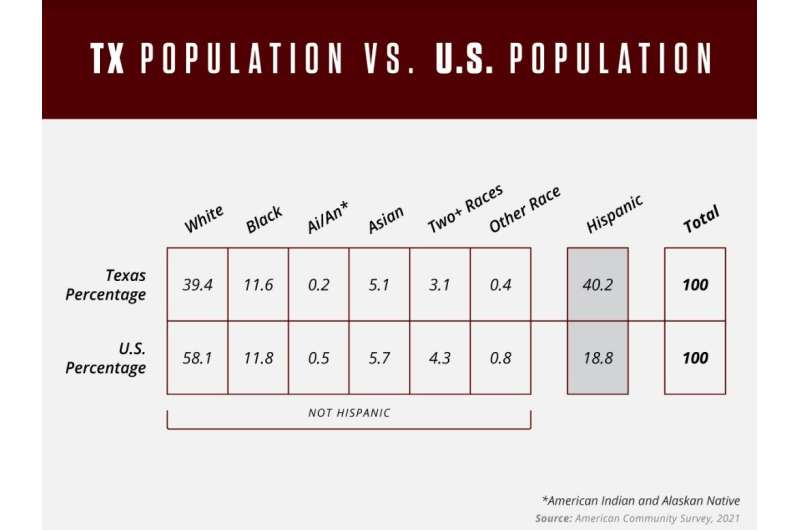Hispanics have become the majority group in Texas. Now what?

For the first time, Hispanics are the largest demographic group in Texas, and a Texas A&M University professor says now more than ever, it's time for state leaders to develop programs and set aside funds to address socioeconomic disparities.
According to new race/ethnic data released by the U.S. Census Bureau last month, Hispanics are estimated to comprise 40.2% of the Texas population, versus white people at 39.4%. Whites are defined in the data as persons who self-identify as white and not as Hispanic. Hispanics are persons who self-identify as Hispanic and may be of any race.
State leaders "need to become aware that Hispanics are the future—indeed the destiny—of Texas," said Texas A&M Professor Emeritus of Sociology Dudley L. Poston, an internationally renowned expert in demography. "If we want Texas and the Texas economy and society to continue to grow and prosper in the years ahead, our Republican leaders must provide the programs and funding to enhance the human capital of Hispanic Texans."
Poston said Hispanics will likely comprise over half of the Texas population in another several decades; Hispanic children in Texas today already comprise half of all children in the state.
But Hispanics in Texas lag far behind white people educationally and economically, he said, citing an analysis by the Texas Tribune of 2021 American Community Service (ACS) data which show Hispanic Texans are disproportionately poorer than white Texans. Hispanics are twice as likely as white people to be living at or below the poverty level. Also, the new ACS data show a significant difference in the median household incomes for white people compared to Hispanic people. White households in Texas have a median income of $81,384, compared to a median income for Hispanic households of $54,857.
There are also sizable differences between the two groups in educational attainment with the ACS data showing that 95% of white Texans have completed at least four years of high school, compared to only 70% of Hispanic Texans. And 42% of white Texans have a college degree compared to only 18% of Hispanics.
In March of this year, Texas A&M announced its designation as an eligible institution by the U.S. Department of Education to be a Hispanic Serving Institution. For HSI designation, at least 25% of an institution's undergraduate enrollment must be Hispanic-identifying.

How does Texas compare with the nation as a whole?
The U.S. is predominantly white—at 58.1%, white people comprise the largest race/ethnic group in the country and comprise the majority. But Texas is a "majority-minority" state, meaning no one group comprises the majority.
Texas is presently one of seven states in the U.S. where whites do not comprise the majority. In addition to Texas, Hispanics outnumber whites in California (40.2% compared to 34.3%) and New Mexico (50.1% compared to 34.9%). In Hawaii Asians outnumber whites, and in the District of Columbia Blacks outnumber whites. In Maryland and Nevada, whites make up a larger share of the population than any other single group, but they do not hold a majority. There are another seven states (Georgia, Florida, Arizona, New York, New Jersey, Mississippi and Louisiana) where white people comprise more than 50% but less than 60% of the population. The states that will lose their white majorities in the next few decades will come from this group, Poston said.
Why has the Hispanic population size increased while the white population has decreased?
Poston said white women have fewer babies than Hispanic women. White women today average 1.5 babies each over their lifetimes, while Hispanics average 1.9. But as recently as 1990, the Hispanic-white fertility difference was larger, white women at 1.9 babies each, compared to Hispanic women at 3.0.
There are also big differences in age structure, Poston said. As recently as 2019, the median age of white people in the U.S. was 43.7, compared to 29.8 for Hispanics. Many more Hispanics are of childbearing age compared to white women. Hispanics also have lower mortality rates than white people.
Immigration is also a factor as many more Hispanics are immigrating to the U.S. than white people. Of the more than 44.9 million people living in the U.S. in 2018 who were born in a foreign country, 50% came from Latin America, 28% from South and East Asia, and only 13% from Europe and Canada.
"Hispanics have increased their representation in Texas and in the U.S. via immigration at a considerably higher pace than the white population," Poston said. "Overall, an aging white population, alongside a more youthful Hispanic population, is mainly responsible for the increasing numbers of Hispanics in Texas and the U.S., and the decreasing numbers of white people."
How are these data collected?
The ACS is a survey sent each year to around 3.5 million housing units in the 50 states of the U.S., the District of Columbia and Puerto Rico. It provides current information every year to states and local areas and communities needed for programs, economic development, emergency management, and other local issues and conditions.
Since the ACS is a survey, it is not a complete count of the population, so the ACS data noted above are estimates of the true population counts. The decennial census, conducted every 10 years (last in 2020), is a complete count of the population. The census counts every person living in the U.S., the District of Columbia and the five U.S. territories. It is an official count of the population and contains many fewer questions than the ACS.
Provided by Texas A&M University



















